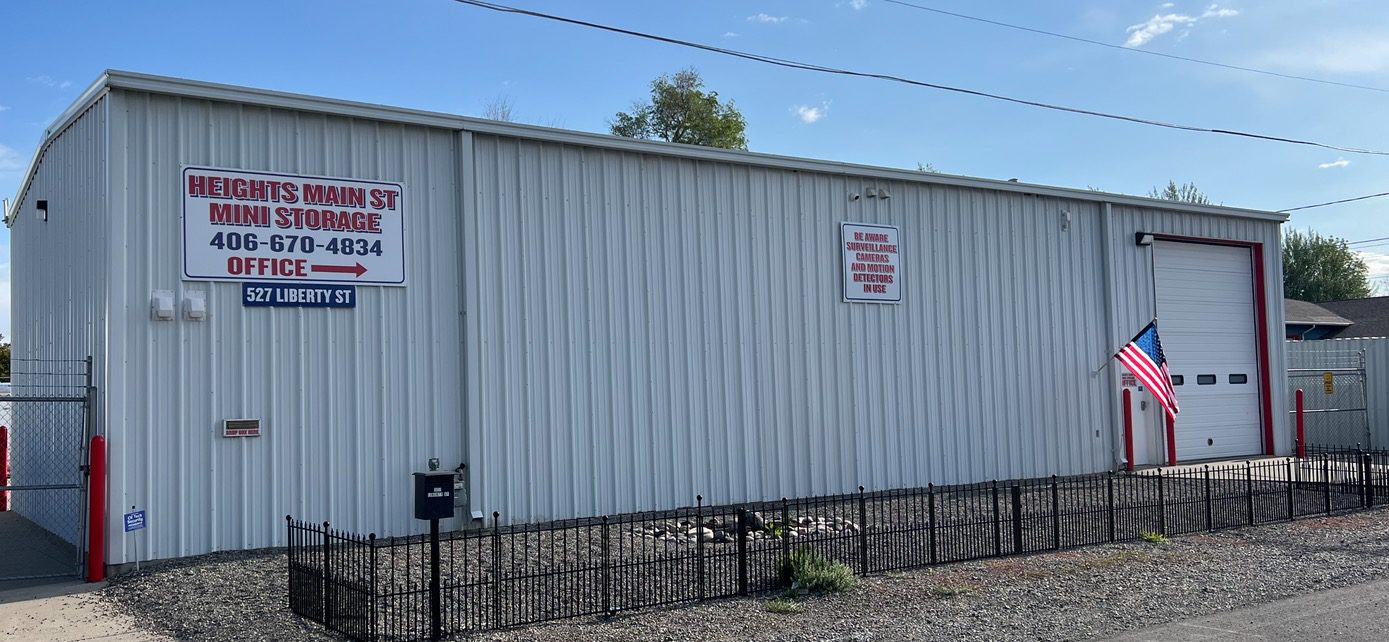Self-Storage Tips
and Frequently Asked Questions
Get Peace of Mind With Our:
- Upgraded High-Definition Video Surveillance Security System
- Easy Access
- Electronic Gate Security
- Multi-Layered Security
- Residential Location
- Excellent Lighting
- Same-Day Services and Appointments
- Walk-In Appointments
- Attentive Customer Service
- Affordability

Packing for Self-Storage
- Make an estimate of the replacement value of each item you store to help with accurate insurance policies and in case of unforeseen damage in the self-storage facility.
- Invest in good quality, sturdy boxes and packing materials - box strength degrades with use. If you buy boxes of similar sizes, it’ll be easier to stack them securely in the self-storage facility and will save you space.
- Box everything that you can - everything that is left unboxed in a self-storage facility will get dusty and potentially dirty.
- Fill boxes to capacity wherever possible to avoid breakages, but avoid making them too heavy - remember you’ll have to be able to lift them. You can use materials such as paper or towels, or can buy special packing to fill spaces if necessary. Depending on the space you opt to rent from your self-storage facility, you might be stacking boxes on top of each other, and the lower levels need to be sturdy enough to take the strain. Boxes that are only partly filled may tip over or collapse.
- Label all boxes clearly so you can identify the contents and keep an inventory. Label them on more than one side so you can see what’s what quickly. Mark "Fragile" on any boxes containing breakable items.
- Don’t be tempted to fill large boxes with heavy items such as books, as they’ll quickly become impossible to carry and may break. You can buy small book boxes from your self-storage facility that will do the job just as well. If you do pack heavy items in a large box, put in just a few and then fill the box up with lighter items.
- Don’t pack items into sealed plastic bags, as humidity can cause mildew.
- Pack books flat to avoid damaging their spines.
- Don’t store wet items in a self-storage facility, as they can cause water damage, mold, and mildew.
- Large appliances need care before being placed in a self-storage facility - make sure you defrost fridges and freezers thoroughly before storing them; otherwise, you’ll be leaving yourself open to water damage. Tie doors up for the move, although you should leave them slightly ajar once in storage to stop condensation from forming and help ward off bad odors.
- Drain washing machines before storing them and tie down hoses, etc.
- Appliances should be clean and dry, and it’ll be worthwhile wiping the insides over with bicarbonate of soda before you store them.
- Wrap all fragile items and breakables, such as dishes, glasses, ornaments, etc., separately. Paper will do, but bubble wrap is a good investment. Pack them tightly into strong boxes, filling any gaps with paper or filler. Try to avoid putting heavy items on top of fragile ones in a self-storage facility.
- If you’re going to be storing clothes, think about buying a wardrobe or clothes boxes - you’ll then be able to simply hang the clothes in them, and they’ll keep their shape. It’s not wise to simply put your clothes in bin liners in a self-storage facility, as moisture can get trapped inside when they’re sealed, and your clothes could be ruined.
- For the best protection for mirrors and pictures in a self-storage facility, wrap them in a protective covering such as bubble wrap and stack them on their ends. Mirrors and pictures should never be stored flat. Mark them as "Fragile."
- Separate lamp bases and lampshades and wrap them for protection.
- If you’re storing upholstered products such as mattresses and sofas in a self-storage facility, it might be a good idea to invest in covers, bags, or sheeting to give them some additional protection. Stand sofas and mattresses on end wherever possible to save space, and don’t stack too much on top of soft furnishings. Mattresses are best stored on the long end and should be ideally raised above floor level or laid on protective sheeting.
- If you’re storing a few items of furniture on top of each other, a simple dust sheet or cover placed between items will minimize scratching and damage in a self-storage facility.
- You’ll save space if you can dismantle furniture such as beds and tables before you store it in a self-storage facility - make sure you keep hold of all the bits so you can get it all back together again! Wrap and cover furniture sections and keep them together, clearly marked, for quick retrieval. You can put components such as screws and bolts together in a plastic bag, mark them clearly, and tape them to the relevant piece of furniture. Store large pieces of furniture vertically to save space in the facility.
- Chairs can be stacked seat to save space. Cover chair legs with protective wrapping for extra protection.
- Spray your wood furniture with a good quality furniture spray before storing it in the facility to give it some added protection.
- Electrical equipment such as TVs, stereos, and computers should be packed in their original boxes wherever possible. If this isn’t possible, pack them into boxes that are about the right size, making sure that you pack gaps with paper. Make sure you tie down the player arm of a record player and secure your turntable.
- If you’re storing items with fuel tanks, such as lawnmowers and cars, etc., in a facility, expect to be asked to drain the tanks before you put them in storage. Fuel is one of the few things that you CAN NOT store in a self-storage facility.
- Wipe down metal objects and tools with a little oil before storing them to avoid rust formation.
- You can tie tools and long-handled items in bundles. Don’t store a brush resting on the bristles.
- Don’t store vacuum cleaners with the bag in - throw it away before you store them in the facility.
- Treat leather items with a leather conditioner before you store them.
- Think hard about whether you really want to store photographs in a self-storage facility. If you do store loose photographs, place them between pieces of clean cardboard and tape them together to avoid curling. Photographs will suffer temperature damage, and if the facility you have chosen is not climate-controlled, you might want to keep them out of storage to avoid losing them.
- Think creatively, and you’ll make more space. Plan to use furniture drawers as an extra box (they are especially good for fragile items), and you can use the inside of wardrobes to store boxes. Kitchen appliances such as stoves and fridges can also be used in this way.
- Seal all your boxes with packing tape before you put them in a self-storage facility - this will help keep dust out of the contents.
Organizing Your Self-Storage Unit
It’s worthwhile taking some time to plan exactly how to pack your items into the unit. Unit sizes are determined by price, so you can save money here by assessing what you have to store and planning to pack it efficiently. A smaller and well-packed unit will be cheaper than a larger one that is badly organized.
There are two key things to remember when organizing your self-storage unit. Firstly, you need to make sure that you can easily access the items you’ve stored in the facility when you want them. Secondly, you must take care when storing. These are your belongings, and there are measures you can take, apart from careful packing, to help protect them during their time in the facility.
- If you’re worried that the floor space in the facility is not clean enough and might cause damage in itself, put down protective sheeting or boards.
- In all but the smallest units, try to create an aisle and leave enough room to be able to get around the back.
- Store your largest items first.
- If you’re stacking your unit high with boxes, always make sure to put the heaviest boxes at the bottom to avoid damage.
- Stack boxes and similarly sized items together to save space.
- Try not to lean furniture against outside walls.
- If you’re storing metal objects, avoid resting them against items susceptible to damage.
- Try to assess what you’ll need to access frequently and keep it at the front of your unit.
- Fill anything that’s hollow - i.e., wardrobes, drawers, washing machines, and fridges with small boxes and other items to maximize your available space.
- Make sure to stack boxes and containers so that you can see the labels you put on them.
- Wedge the doors of all kitchen appliances whilst in the facility to avoid bad odors and mildew, etc., building up.
- Don’t store anything in the facility that you’re not sure is sturdy vertically - if it seems wobbly, store it horizontally.
- If you’re worried about the atmosphere/environment in the unit, put down moisture absorbers, deodorizers, and vermin bait.
Frequently Asked Questions (FAQ)
Storage Unit access is available: 6 a.m. - 10 p.m.
RV & Boat access is available: 24/7/365

Call Us
Drive right up to your door! Our lot is set up so that you can park right in front of your door to easily load and unload your items. No elevators and no stairs!
Call (406) 670-4834
